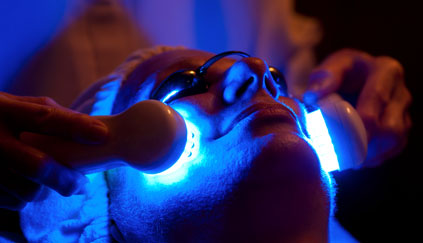
Materials chemist and engineer Adah Almutairi is director of the Center for Excellence in Nanomedicine and Engineering at the University of California, San Diego, where her team explores novel material properties. Our bodies have a habit of scattering medicine to the wrong places, so she is targeting diseases with light-activated nanoparticles.
What medical challenge does your nanoengineering address?
Biology operates at the nanoscale, so materials designed at that size can respond better to disease. Right now, we have very little control of where, when, and how drugs act in the body. We want these processes to work precisely, to minimize off-target drug effects.
How are you improving drug targeting?
One way is by making materials that respond to inflammation, which underlies lots of major diseases. First we string together molecules to create polymers, which we build into nanoscale containers that resemble balls of tangled yarn. In trials with mice, we’ve filled these with drug molecules that the spheres release when inflammation flares up, and stop releasing when it subsides.
What size are these balls?
A blood vessel in your thumb is about 1 millimeter across. A single blood cell is about 1,000 times thinner. And finally, our nanoparticle is one-thousandth the size of a blood cell.
How can inflammation trigger drug release?
The start of inflammation involves the buildup of reactive oxygen species and acidic byproducts of metabolism. When there’s no inflammation, the spheres are as stable as a rock, but when they encounter acid and ROS, the spheres release their contents.
Can you tell me about the nanospheres you made that open when hit with light?
For those we use a similar release mechanism to that of our inflammation model, but we harness near-infrared light rather than acidity or ROS to break open the spheres in exactly the right locations. Near-infrared has a useful mix of properties: It can penetrate tissue while keeping a straight path, so it can be precisely targeted.
Have you tried these on animals yet?
Yes, we started with back-of-the-eye diseases. For these conditions you need regular drug injections into your eye. It’s very invasive, and the more injections you have, the greater your risk of scarring and retinal damage. You also need a skilled surgeon: Not just anyone can poke you in the eye. So there’s a big need for a single injection that releases therapeutics over time. We began using our nanospheres to encapsulate a small molecule that treats age-related macular degeneration. When you shine light into the eye, you release a dose of the drug. The spheres can stay intact for a year before safely degrading.
How else could these nanospheres be used?
We want to do the same thing with diabetes. So instead of people with the disease having to inject themselves with insulin when they finish a meal, we want them to be able to just shine light on their abdomen or arm. Another thing is light-activated sunscreen. It wouldn’t do the chemistry to protect your skin when you apply it, but only when you go into the sun. That would be smarter than having to reapply sunscreen willy-nilly.
New Scientist

